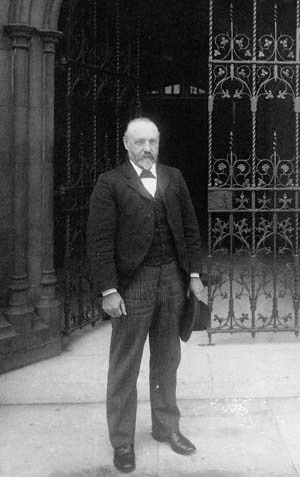Valerie Amin recently graduated from the University of the Highlands and Islands with a BA (Hons) in Scottish History. A native of Caithness, she is particularly interested in the land issues and politics of the 19th century Highlands. The following continues the story from August’s post and is adapted from her undergraduate dissertation ‘Caithness and the Highland Land Wars, 1881-1886.’
The rent strike on Clyth estate ensured that Caithness was included in the Napier Commission’s inquiry into crofters’ conditions. The Commission came to Lybster Free Church on October 4th 1883. The hearing was full to capacity, with spectators taking a ‘lively interest’ in proceedings. Adam Sharp, landlord of Clyth estate, struggled to make himself heard over the laughter and hisses that greeted his testimony. Indeed Lord Napier was forced to end the hearing following Sharp’s appearance, saying the Commission could not continue ‘amidst a riotous assemblage.’ Unsurprisingly, Sharp refuted his tenant’s allegations that he charged unreasonably high rents.
Magnus Sinclair from Clyth, in his statement to the Commission, summed up very simply what Caithness crofters sought: ‘What we want is our holdings valued by competent local judges, compensation for improvements, and that the land of our country be given to its people to live on at a fair rent.’
![JN25114B043_Cliffs near Bruan[14701542]](https://historylinksdornoch.files.wordpress.com/2019/08/jn25114b043_cliffs-near-bruan14701542.jpg?w=584)
Part of the coastline at Clyth ©Johnston Collection. Used with the kind permission of the Wick Society.

Gavin Brown Clark (1846-1930) by Sir Benjamin Stone, 1898. © National Portrait Gallery http://www.npg.org.uk https://creativecommons.org/licenses/by-nc-nd/3.0/ |
By the year’s end, the Third Reform Act passed into law, establishing uniform voting rights throughout the country, and enfranchising many crofters and farm servants. The 1885 general election was fought in Caithness on a single issue: the land question. Major Clarence Sinclair, son of the incumbent M.P Sir Tollemache Sinclair, who was the second largest landowner in Caithness, stood for the Liberal Party against Dr Gavin Brown Clark for the Crofters Party. At a meeting in Lybster, Sinclair was told ‘All crofters know that new seed will bring a better return. We have had the House of Ulbster for many years. We need a change.’
On election day in December, crofters battled determinedly through howling winds and drifting snow to get to the polls. Many roads in the county were blocked, but the crofters were not about to give up the chance to have their voices heard. Turnout was high, and Clark beat Sinclair comfortably by 2,110 votes to 1,218, a majority of 892.
The Crofters Holdings Act (Scotland) became law in June 1886 but, condemned as ‘incomplete and unsatisfactory,’ the crofters’ fight was destined to continue. Dr Clark told his constituents the Act was ‘but an instalment of their rights- ten shillings in the pound,’ and they would ‘go on demanding till they got the other ten shillings.’
Sources
John O’ Groat Journal
Her Majesty’s Commissioners of Inquiry into the Conditions of the Crofters and Cottars in the Highlands and Islands of Scotland, Volume III (1883).
Northern Ensign
